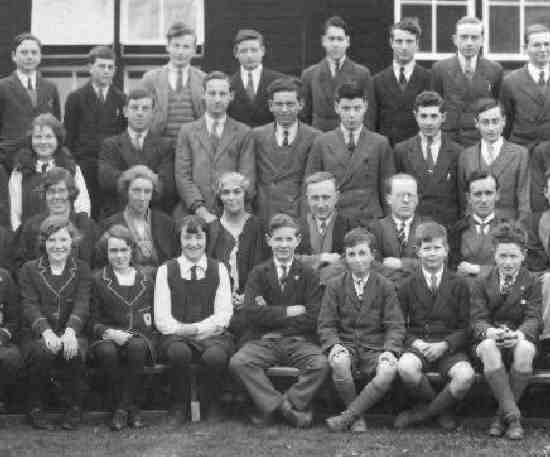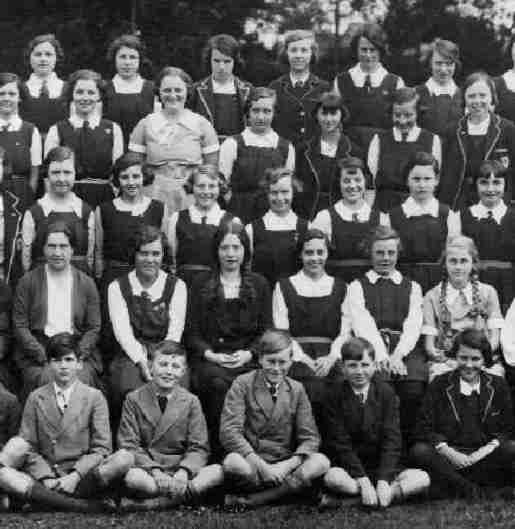
Some schools have evolved over time and in fact have functioned as several different types of schools. Often changes at the school have reflected developing trends in English education. Brockenhurst was founded in 1909, originally as a Pupil Teachers' Centre. A Pupil Teacher's Center was a school where promising girls as young as 13 learned to be teachers. Over time the school progressed through a series of changes: pupil techers' centre, county school, county high school, grammar school, and college. County schools were generally coeducational schools and Brockenhurst was a coeducational grammar school-a rarity in England. It is now a coeducational 6th form college. The transitions at Brockenhurst represent an interesting look at changes in English education.
Brockenhurst never had any religious affiliation or received any funding from ecclesiastical authorities. It was always funded by the Hampshire Education Authority. The Wesleyan Church Sunday School room was used simply because it offered suitable (presumably rented) accommodation. [Sloan] I am not sure, but I think there may have been required religion classes, even though the school was not affliated with any religious denomination. This we have to confirm. A former student writes, "Two periods of religious lessons (known as scripture lessons in the 1940s and changed to religious knowledge in the 1950s) were given each week but were not compulsory for non-Church of England pupils. I was envious of two Catholic girls in my form who sat in the corner doing their homework! The day started with morning assembly at which a hymn was sung and the Lord's prayed recited after which the Head gave out any general notices--attendance by non-C of E pupils was optional." [Sloan]
Brockenhurst College and the schools that it evolved from have quite a complicated history. Brockenhurst was founded in 1909, originally as a Pupil Teachers' Centre. A Pupil Teacher's Center was a school where promising girls as young as 13 learned to be teachers. Over time the school progressed through a series of changes: pupil techers' centre, county school, county high school, grammar school, and college. County schools were generally coeducational schools and Brockenhurst was a coeducational grammar school-a rarity in England. It is now a coeducational college. The school has operated continuously since 1909. The many changes in the name of the school reflect the changing educational policies and public attitudes toward education in England. In particular the comminity seems to have differed on whether they wanted a selective or non selective academic program.

Figure 2.--We are not sure just when Brockenhurst became a county school. The uniform was little changed in 1930, except that girls had begun to wrar ties and a few junior boys wore long trouser suits. |
Brockenhurst was founded in 1909, originally as a Pupil Teachers' Centre. A Pupil Teacher's Center was a school where promising girls as young as 13 learned to be teachers. Pupil Teachers' Centres were first established in 1846. The girls had to demonste a capability in basic numeracy and literacy skills. The school in 1909 began in the Wesleyan Church Sunday School room with only about 18 children. From the beginning it was a coeducational school. The school proved very successful and by 1929 had grown to over 200 children .
Even in the early 1900s there was no gender discrimination in Pupil Teacher Centres! Promising PUPILS acted as teachers, not just girls. [Sloan]
As a county school the enrollment grew to nearly 400 students.
I believe as a county high school, Brockenhurst began working only with the older pupils. Enrollment grew to over 800 pupils. As a county high school. the intake was from the age of 11. This was contstant through all the various incarnations of te school's name. [Sloan]
One reader tells us that the school was turned into a grammar school in 1950 by the unilateral action of the headmaster [Sloan]. At a grammar school, children had to do well on the selective 11+ examination. The school was one of the few coed grammar schools. Some county school officials wanted to turn Brockenhurst in to a boys' grammar school but school officials resisted these efforts. A former student tells us, "I was at Brock when it changed from high school to grammar school and there was no publicly stated reason for the change. Certainly the name change did not reflect any changes in public opinion on education or on the school. The terminology County High School was unusual (Brock was the only one I knew) whereas Grammar School was quite common. Researching it later, all I could find was that "some people" thought County High School was
feminine. I would guess that "some people" was in fact the new headmaster. First he changed the name - then later the school motto (without any prior warning even to the staff as my website documents from the school magazine editorial written by the senior English master). Two years after he changed the name to Brock Grammar School, it suddenly changed back to County High School for several years before the Hampshire Education Authority sanctioned the change." [Sloan]
We are not sure precisely how the name change was reflected by the academic program, but it may have meant a change to a non-selective comprehensive program.
This time the change to a grammar school was agreed to by the County Education Authority. We thought this meat a selective academic program. It appears, however, that the change in name did not reflect
an actual change in the academic program as far as we can tell. In Britain "grammar school" had a much more prestigious image than "high school".
Brockenhurst Grammar School decided to convert to a sixth form college in 1969, leaving the lower school education to be carried out by the surrounding comprehensive schools. Accordingly, in 1969 the name was changed to Brockenhurst College. Colleges in England are secondary schools or combined elementay-secondary schools. They are often private schools, but like Brockenhurst they are also state secondary schools--usually advanced 6th form studies. Brockenhurst now has over 2,000 pupils.

Figure 3.--This school photograph was taken in 1934. Brockenhurst at the time was still a county school. The uniform appears little changed from the 1926-30 period. |
We have no early photographic images from Brockenhurst. Photographs in the 1920s show all the junior boys wearing short pants suits, although the styles and colors varied. The girls wear gym slips of varying style, but apparently the same color. Some wear blazers with piping, but none of the boys wear blazers. Girls wore long stockings while the boys wore kneesocks.
HBC has some time-line data about the school. Information on the uniform from photographs is available from 1926.
A photographs from 1926 show all the junior boys wearing short pants suits, although the styles and colors varied. The school appears to have required all boys tonswear suits. The short pants for the junion boys presumably was not a school requirement, but just what most boys wore in the 1920s. The girls wear gym slips of varying style, but apparently the same color. Some wear blazers with piping, but none of the boys wear blazers.
We are not sure precisely when Brockenhurst made the transition from Pupil Teacher Centre to county school. The uniform appears littkle changed from 1926. More girls are wearing blazers and many now wear ties. The boys are still not wearing blazers, but all cvontinue to wear non-uniform suits. The junior bpys still wear short trouser suits, although a few have long pants.
We are not sure precisely when Brockenhurst made the transition from Pupil Teacher Centre to county school, but by 1934 it was probably a county school. The uniform, however appears little changed from the 1926-30 period. The girls uniform is little changed from 1930. The boys still wear various styled suits rather than a uniform. There appear to be a few more darker-colored suits than earlier. There also appear to be more double-breasted suits. Even several junior boys wear them. Even more boys appear to be wearing short trouser suits than in 1930.
One question we have in interpreting the various Ebglish school photographs is if the children dressed up for school phiotograph day or if the photographs reflects how the children dressed on a normal day. An old boy from Brokenhurst tells us, "There was no advance warning of school photographs, pupils were just marched
out of class in their normal clothes." [Sloan] We are not sure if this was the common practice at other schools.
The Brockenhurst Old School Association maintains a wonderful web site on the school. At HBC we are primarily interested in the uniform and how styles have changed over time. The Brockenhurst site with its extensive collection of photographs offers a wonderful opportunity to study changing fashion trends over time. The school site, however, includes much more interesting information about the school. The web site terminates at 1970 when the school became a sixth form college. There is no Brockenhurst College Old Students Association.
Sloan, Colin. E-mail message, September 23, 2004.
Related Chronolgy Pages in the Boys' Historical Web Site
[The 1880s]
[The 1930s]
[The 1940s]
[The 1950s]
[The 1960s]
[The 1970s]
[The 1980s]
